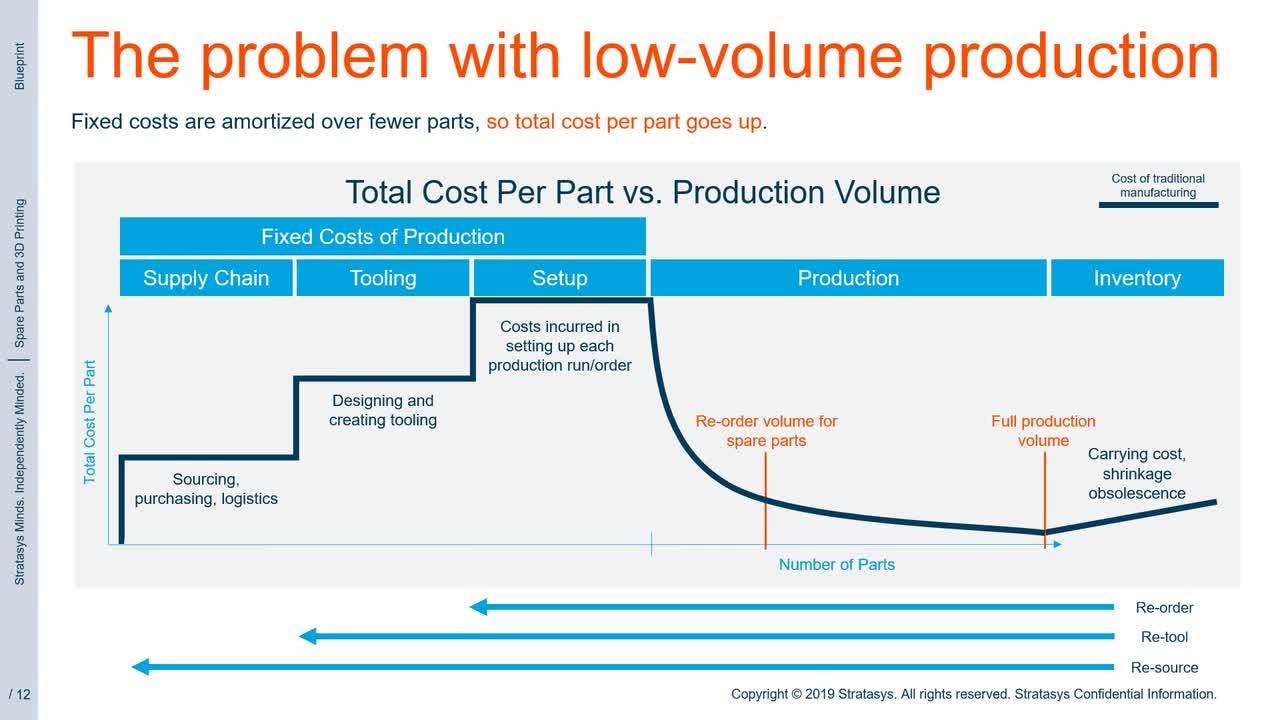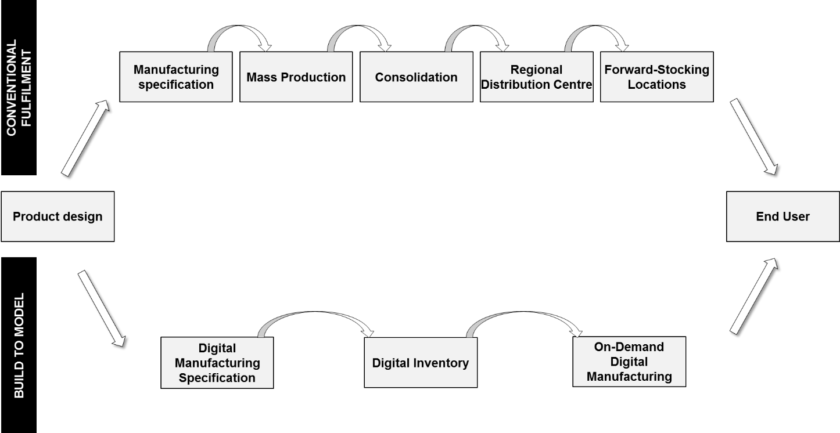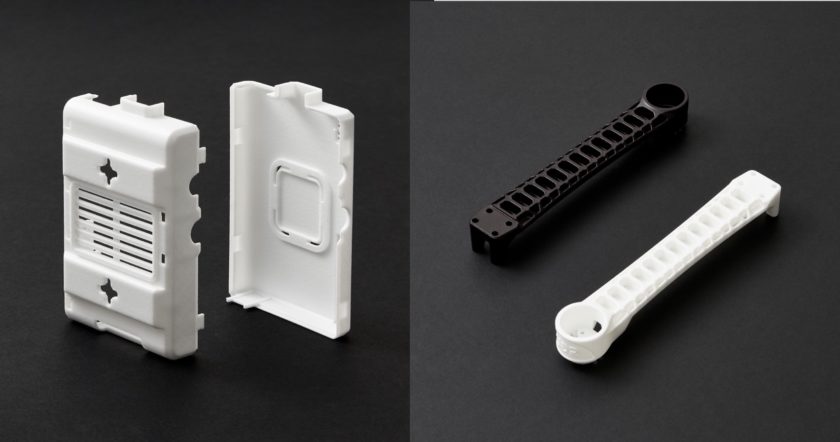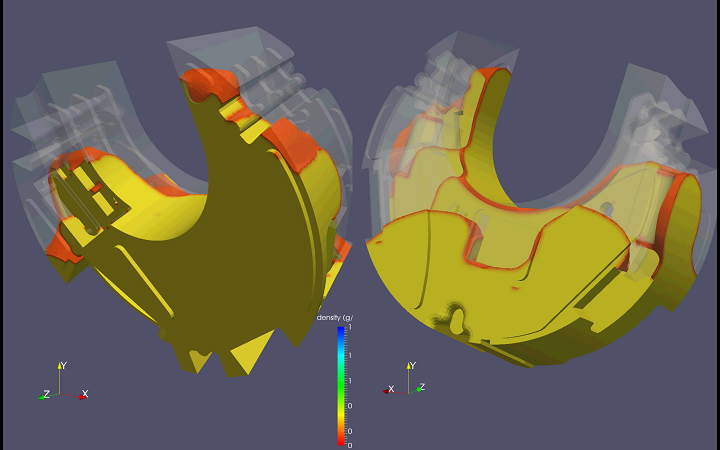Blueprint Webinar: The Business Case for 3D Printing Spare Parts
In the next decade, 3D printing will massively reduce costs and create new revenue opportunities in spare parts businesses. This growth will be driven by 3D printing’s unique ability to eliminate fixed costs in manufacturing and radically reduce lead times.

The first step in unlocking the potential of 3D printing in your spare parts business is to understand the business case.
In this webinar Aaron Hurd, Consulting Manager at Blueprint, gives an overview of the business case for 3D printing spare parts. He explores both the high-level business case and gives tactical examples of how 3D printing is uniquely positioned to solve cost and lead time issues that often plague spare parts businesses.
In this webinar, you will:
-
- Learn how and why 3D printing solves the problems of cost and lead times in spare parts.
- See real examples of applications where 3D printing provided savings in both cost and lead times.
- Hear stories of how leading companies are innovating using 3D printing in their spare parts businesses.
- Gain an understanding of what it takes to deploy a 3D printing capability.
- See actionable steps to take for jumpstarting 3D printing in your spare parts business.

Blueprint is the world’s leading 3D printing consultancy. We’re engineers, innovators, analysts, and strategists with 15 years of experience helping clients across virtually every industry, at startups and Fortune 500 companies alike. We are laser-focused on helping our clients make sense of 3D printing, from high-level strategy and innovation, to deeply technical design optimization.
If you want to discuss this article or your additive manufacturing strategy, the team at Blueprint is here to help. Let’s say hello.
hello@additiveblueprint.com
The post Blueprint Webinar: The Business Case for 3D Printing Spare Parts appeared first on 3DPrint.com | The Voice of 3D Printing / Additive Manufacturing.
ExOne licenses ORNL ceramic-metal 3D printing to make neutron imaging components
Revolutionizing Supply Chains With 3D Printing
We already know that 3D printing is a game changer. Additive technology not only allows previously unmakable products to be built in a matter of hours; it also allows them to be built anywhere in the world. Alone, these two features signal an enormous impending impact for the manufacturing industry, particularly when it comes to their supply chains. But what will this impact be? How are things going to change?
Panalpina, Shapeways and Cardiff University have teamed up to address exactly this question. The result is an innovative and thought-provoking paper that sheds new light on the future of 3D printing and supply chains. The paper, “Economies of collaboration in build-to-model operations”, has just recently been published online.
The paper explores how additive manufacturers should approach order fulfillment across the 3D printing industry, building on an existing case study from Panalpina and Shapeways. The authors propose a brand new manufacturing mode – Build to Model (BTM) – which summarizes all the manufacturing and logistics information required to produce and deliver 3D printed products to the end customer. This approach has the potential to be a quicker, cheaper and less environmentally damaging way to produce goods. BTM represents a brand new B2B model with the potential to revolutionize supply chains and completely change how we approach 3D printing.
What is “Build to Model”?
Thanks to the huge popularity of Lean Management and other continuous improvement programs, many people are now familiar with Just in Time delivery or Make to Stock vs Make to Order; they have become almost everyday business concepts. When goods are ‘Make to Order’, for instance, a manufacturer will have the right parts or materials to hand in order to produce a final product on demand. The manufacturer assembles this bespoke product directly for the end customer; and its supply chain supports the process of providing all necessary components.
With ‘Build to Model,’ the manufacturing process changes completely because 3D printing enables a delay in the choice of manufacturer until the day of production. Product design becomes the pivotal part of the process, instead of the supply chain. A product can be 3D printed anywhere in the world at any time: designers can upload their data files to a preselected manufacturer’s website, and manufacturers can bid for the work in an electronic marketplace.
‘Build to Model’ means manufacturers can take on more work than their in-house capacity allows: it’s easy to outsource an order to an external 3D printer as it requires no customer-specific tooling, jigs, fixtures or fittings. 3D printing brings consistency of product and makes it possible to select printers close to the end customer, saving a business time and money by simplifying assembly operations and reducing handling and warehousing.
In essence, the ‘Build to Model’ approach uses 3D printing to give manufacturers more flexibility. It cuts out the need for a ‘timeline’ approach to manufacturing (ordering, supplying, warehousing, etc) and fully enables a “Make-to-Order” fulfillment strategy.
Conventional Fulfillment vs Build to Model

Why do we need BtM?
Organizations are under increasing pressure to up their ante and “get ready for Industry 4.0”. But how many executives really know what this means? How many businesses are actually prepared for a digital, data-driven world? Business model innovation has never been more critical for organisations, and entire industries, in order to update and adapt their processes and survive the switch to digital. 3D printing in itself allows a rapid overhaul of existing manufacturing and supply chain processes – the shape of the new remains to be defined, and this is why we need innovations such as a ‘Build to Model’ approach.
‘Build to Model’ operates in a virtual world, shifting the emphasis from materials and supply chains to printer capacity and digital modeling. Manufacturers no longer need to keep component parts in stock; instead of moving materials to reach the market, the 3D design file is simply sent by the customer to the manufacturer, who sends it to the printer along with the material and machine specifications.
‘Build to Model’ leads the way to a simpler manufacturing world, where a network of collaborative 3D printing companies can coexist, sharing product designs globally, to produce goods on demand at the touch of a button. Currently, it is particularly relevant for the growing industry of additive manufacturers who produce products both for industry and for consumers.
How did BtM come about?
“The partial outsourcing relationship between Shapeways and Panalpina demonstrates the potential for general purpose manufacturing technology to disrupt the conventional supply chain model.”
Panalpina, one of the world’s largest third party logistics organizations, introduced a 3D printing operation several years’ ago at their facility in Eindhoven, in the Netherlands. The purpose of the facility was to produce 3D printed parts for Shapeways, a global leader in additive manufacturing for the consumer market. Together, the two companies developed a collaborative model of outsourced 3D printing, to expand 3D printing capabilities, create leaner supply chains, lessen environmental impact and reduce costs.
The partnership between Panalpina and Shapeways realized the full potential of the ‘Build to Model’ approach. The partnership allowed the companies to outsource 3DP work to each other, successfully balancing demand and capacity.
Cardiff University joined the collaboration through the Panalpina Centre for Manufacturing and Logistics Research (PARC). PARC is a research centre specializing in inventory forecasting, distributed manufacturing and additive manufacturing. It is a unique endeavor between an organization and academia; and it is through PARC that the ‘Build to Model’ approach was developed. Researchers from PARC approached Panalpina and Shapeways to investigate their 3D printing partnership and to develop new models of supply chain based on the possibilities of collaborative 3D printing.

What’s next for BtM?
“The future role of 3D printing in supply chains depends on developing new ways of operating to simplify current supply chains and to create new types of supply structures.”
The ‘Build to Model’ concept is still in its infancy; it represents an enormous shift in ways of doing business, and most established organizations will be slow to adapt. But adapt they will; additive manufacturing is becoming more and more prominent as the technology develops. 3D printing is well on the way to becoming a mainstream method of production, and those that do not take advantage of the new possibilities enabled by 3D printing will be left behind.
Existing additive manufacturers will already see a major impact of ‘Build to Model’ within their own operations. Old, traditional supply chains simply will not work effectively for these new types of business and they will already have adapted their supply chains and production strategies to fit.
Investigations such as the project carried out by Cardiff are absolutely critical for redefining best practices, allowing industry to make the necessary changes to prepare for a digital world of 3D printing and distributed manufacturing, on-demand, all over the world.
About Panalpina: Panalpina is a global 3rd Party Logistics provider, offering air freight, ocean freight and logistics services to tens of thousands of customers around the world.
About Shapeways: Shapeways is redefining product creation. Shapeways enables businesses to bring their ideas from inception to post production and fulfillment with its end to end solution offerings in 3D printing manufacturing. Founded in 2007, Shapeways is headquartered in New York City and has factories in Long Island City, the Netherlands, and a network of innovative partners around the world. Shapeways has a network of over 1 million businesses and has printed over 10 million products.
About Cardiff University: Cardiff University is recognized in independent government assessments as one of Britain’s leading teaching and research universities and is a member of the Russell Group of the UK’s most research-intensive universities. The 2014 Research Excellence Framework ranked the University 5th in the UK for research excellence. Among its academic staff are two Nobel Laureates. Founded by Royal Charter in 1883, today the University combines impressive modern facilities and a dynamic approach to teaching and research. Cardiff’s flagship Research Institutes are offering radical new approaches to pressing global problems. www.cardiff.ac.uk
Authors:
Katy Alice Huckle – Panalpina
Ryan Iwanski & Giovanni Colantonio – Shapeways
Heath Jeffries – Cardiff University
The post Revolutionizing Supply Chains With 3D Printing appeared first on Shapeways Magazine.
Curtiss Motorcycles Use Hybrid Manufacturing For Electric Bike
Advanced manufacturing firm Fast Radius has just revealed that it has been working with Curtiss Motorcycles on the Zeus 8 electric model. The company will be producing parts for the vehicle using hybrid manufacturing, employing a mix of CNC and Additive methods. Reportedly, Fast Radius are working on over 60 different components of the bike. […]
The post Curtiss Motorcycles Use Hybrid Manufacturing For Electric Bike appeared first on 3D Printing.
UCLA granted $1.5 million to develop eco-friendly 3D printable concrete
3D Printing & Conductivity: Fabricating Ultra-Stretchable Conductors
Researchers in Shanghai are delving further into 3D printing conductors, with their findings recently published in ‘A highly transparent and ultra-stretchable conductor with stable conductivity during large deformation.’ Authors Zhouyue Lei and Peiyi Wu follow up on the increasing development of stretchable conductors and improvements being made in their electromechanical properties, along with studying issues with deformation and defects—and ways to break through such limits.

Molecular synergistic design. a Schematic illustration of the molecular synergistic design, including the optimized ion-rich structure predicted by DFT and the dynamic hydrogen-bond networks. b The true tensile stress–strain curves of the conductors with different contents of the IL. The strain rate is 0.17 s−1. c The SAXS profile of the intrinsically stretchable conductor. The inset picture is the AFM phase image of the conductor. (scale bar: 100 nm) d IR spectra and corresponding second derivative curves of the intrinsically stretchable conductor, PAA, PDMAPS, and IL in the region of 1750–1600 cm−1
Soft materials, and especially conductive ones, are critical in applications for artificial intelligence and biological systems; however, it takes some doing to get them into a softer and more flexible form. Plasticizers and flexible segments added to the polymers are one way to create softer regions, along with adding conductive elements like electronic fillers or ionic electrolytes and then managing the paths and networks.
The researchers endeavored to create soft nanochannels, connected with crosslinked networks:
“Herein, we introduce a type of intrinsically stretchable conductors. Small-molecular liquid-like electrolytes, such as ILs, provide charge carriers; polymers with similar ionic structures, e.g., polyzwitterions, realize ionic synergy with the liquid electrolytes and thus assemble conductive nanochannels to avoid aggregates or leaking risk of the electrolytes; dynamic networks are constructed by polymers that also have molecular synergy with the conductive nanochannels, to guarantee the structural integrity, deformation adaptability and environmental stability.”
The conductor can store, create, and send electrical signals through the flow and distribution of ions and nanochannels, with the paths ‘dynamically adapting’ to deformation. The authors point out that the material is also suitably stable, demonstrating a three percent change of conductivity in 24 hours, and exhibiting no melting point or glass transition in extreme temperatures.

Electrical properties in dynamic environments. a Schematic illustration of the conductive paths in this material adapting to deformation. Blue lines represent ion nanochannels and the purple parts represent the dynamic networks. b Photographs of the 3D-printing conductor during a stretch-release cycle (scale bar: 2 cm). c The stability of the ionic conductivity during the deformation process. d The relative changes in ionic conductivity in the temperature range of −10 to 100 °C (error bars: standard deviations). e The stability of the ionic conductivity at extreme low or high temperatures for a long period. These measurements are humidity control (60 RH%)
The research team found the stretchable conductor to be promising for use in soft robotics, and the ability to provide sensing capabilities. The nanoscale paths could be suitable for adapting to larger deformation issues, along with direct exposure to outside elements.
“Benefiting from the rational designs, this material not only breaks through the limits encountered in current electronic and ionic conductors, with good transparence, ultra-stretchability, high modulus, reconfiguration of the elastic networks, etc., but also greatly improve the stability in dynamic environments,” concluded the researchers.
“We believe that current work addresses a long-lasting challenge in the field of intrinsically stretchable conductors, provides general inspiration for the nanostructural designs and device fabrications, and could also promote the development of intelligent robots with the requirements for entire softness, high transparence, multiple sensory capabilities, and environmental stability.”
3D printing and conductive materials are often paired up in the fabrication of electronic components, from desktop filament to composites, and research into studies using silicone. What do you think of this news? Let us know your thoughts; join the discussion of this and other 3D printing topics at 3DPrintBoard.com.
[Source / Image: ‘A highly transparent and ultra-stretchable conductor with stable conductivity during large deformation’]
The post 3D Printing & Conductivity: Fabricating Ultra-Stretchable Conductors appeared first on 3DPrint.com | The Voice of 3D Printing / Additive Manufacturing.
Simulation First Initiative Helps Honeywell Engineers Find Optimal Parameters for 3D Printed & Machined Parts
 Honeywell FM&T, an engineering, manufacturing and sourcing enterprise that’s part of aerospace company Honeywell, manages and operates the Kansas City National Security Campus (KCNSC) for the US Department of Energy (DOE). In addition to providing technical services like metallurgy, analytical chemistry, and simulation tools, its mission is to make non-nuclear mechanical, electronic, and engineered material components for national defense systems. Honeywell and the KCNSC are collaborating with Sandia National Laboratories on a new initiative called Simulation First.
Honeywell FM&T, an engineering, manufacturing and sourcing enterprise that’s part of aerospace company Honeywell, manages and operates the Kansas City National Security Campus (KCNSC) for the US Department of Energy (DOE). In addition to providing technical services like metallurgy, analytical chemistry, and simulation tools, its mission is to make non-nuclear mechanical, electronic, and engineered material components for national defense systems. Honeywell and the KCNSC are collaborating with Sandia National Laboratories on a new initiative called Simulation First.
Sim First was launched by Honeywell engineers at the campus, and is helping them reduce costs, while driving manufacturing speed and productivity, at the same time – before they even reach the prototype stage.
“The effort uses physics-based tools to simulate production operations – all while in the concept phase,” Tanya Snyder, the Communications Manager for Honeywell and a Contractor for the KCNSC, told 3DPrint.com. “This reduces the number of tests required to find the right process and manufacturing parameters for 3D-printed and traditionally machined parts, resulting in less cost and production time.”
This strategic partnership marries Sandia’s code development skillset with the KCNSC’s use of simulation in critical and continuing production processes. In the past, the KCNSC has partnered with Sandia on 3D printing replacement parts for a nuclear warhead, and has also worked with Honeywell on tool design.
Before Honeywell’s ideas even leave the concept phase, the Sim First program uses tools and algorithms to figure out when and where materials could break, in addition to how well they will stand up under extreme temperatures and shock…obviously important when it comes to applications regarding the country’s national security. The program lets the engineers know if their parts are the right firmness, structure, and weight. Finally, calculations will optimize the final design and develop the optimal manufacturing parameters and processes for the product, whether they’re traditionally or additively manufactured parts.
Snyder provided us with a good example of how Sim First works that involves creating foam parts, which, because of their processing procedures and complicated chemical make-up, have always had low production yields in the past.
“Under SimFirst, the KCNSC and Sandia worked together to find a way to predict the expansion of Polyurethane foam in an enclosure,” Snyder explained.
“Sandia developers created a model that’s now been applied 400+ times at the KCNSC. The model predicts the fill behavior of every encapsulated component being developed for production. The end result has been the creation of fewer physical prototypes and a faster development schedule.”
In the above image, you can see an encapsulation fill simulation, which provides Honeywell engineers with the product’s “optimal density and fill levels,” all before they even start to work on the final prototype itself. Early access to this kind of data can really help lower the costs and time that are part of the life cycle of product development.
What do you think about this initiative? Discuss this story and other 3D printing topics at 3DPrintBoard.com or share your thoughts in the Facebook comments below.
The post Simulation First Initiative Helps Honeywell Engineers Find Optimal Parameters for 3D Printed & Machined Parts appeared first on 3DPrint.com | The Voice of 3D Printing / Additive Manufacturing.



